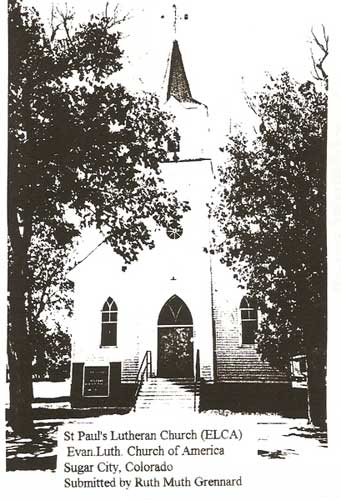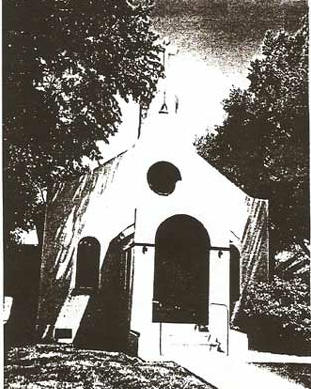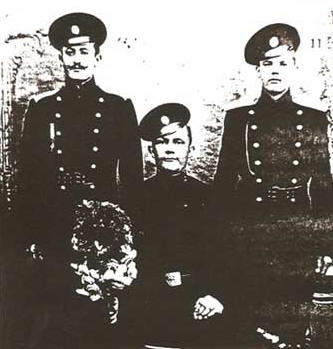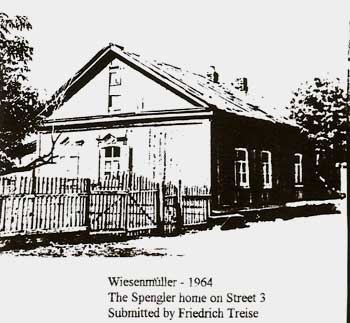
| Return to Jeruslan Nachricten Newsletters | Return to Jeruslan main page |
JERUSLAN NACHRICHTEN
1994
Vol 1 No 1
by Gotthardt GraubergerVol 1 No 2
Vol 1 No 3
Vol 1 No 1
Genealogical Success in Germany
Bill Wiest writes that he ahs had a quite favorable experience with Professor Pleve of the History Dept at Saratov State University in Russia. Dr. Pleve used the Saratov Archives to identify the first Buxman family (Billís motherís maiden name) to come from Germany to the Volga area (village of Muller) in 1767. While they were in Germany this past summer, Bill and his wife, Thelma, visited the Evangelical Lutheran Church Archives in Darmstadt, Germany and confirmed the names, marriage date, village of origin (Reinheim) and occupation (master tailor) of this first Buxman to go to the Volga.
For those of you interested in the Buxman line, Bill Wiest is the son of Katherine Elizabeth Buxman b 1910 Windsor, CO, the daughter of Karl Adolf Buxman b1879 Wiesenmuller; the son of Peter Buxman b1838 Muller; the son of Andrew Buxman. Other family names intermarried with Billís Buxman line include: Weber, Mohn, Helfenbein, and Greb
Vol 1 No 2
St. Paulís German Evangelical Lutheran Church at Rocky Ford, CO by Ruth Muth Grenard
St Paulís German Evangelical Lutheran Church of Rocky Ford, CO was founded when 39 families of German Russian immigrants decided, in 1910, to purchase some land on which to build their church building from George Darling. Darling was related to Senator George Swink, founder of Rocky Ford, CO. This land was part of a larger parcel obtained from the US government by way of a Patent to Senator Swink. The German Russian group was headed by Rev. Gustav Wiencke, who was the head f the parent board of the local church group which was incorporated in 1911.
The membership of this church of German Russian immigrants was enticed to the Rocky Ford area by the American Crystal Sugar Company to work in the sugar beet industry as field laborers. Many of these immigrants were first brought into the area by way of railroad boxcars to the Sugar City, CO area (about 25 miles from Rocky Ford) and, after living for awhile in a tent city in that area, were transported to Rocky ford for the beet labor.
St. Paulís founders actually began work on the church building in 1910 with members of the church donating their labor. By sometime in 1912 the building was completed and work was then begun on the adjacent house which was constructed as the church parsonage.
Originally this congregation was a part of the German Evangelical Lutheran Immanuel Congregational Church of Rocky ford, but a split occurred in the congregation in May of 1910. What was to become the St. Paulís congregation began meeting at the old Park Hotel in Rocky Ford. Between 1915 and 1916 the congregation split again when about half of the original 39 families moved to an area east of La Junta, CO (about 25 miles away from Rocky Ford) and established churches there.
Over the years the membership of this congregation dwindled and the last services of the German Russian descendants were held there sometime in the 1970ís. Another congregation then held services in the building for some time.
According to a Rocky Ford Daily Gazette newspaper article dated 14 June 1974, at that time only two of the original St. Paulís Board members were still living: Fritz Elsesser and George Brick. Other original Board members were: Fritz Freidenberger, Michael Will, Jacob Bender, Henry Elsesser, and Henry Abert. Ministers who served full time over the years include: Rev. I Hopp, Rev. George Juttner, Vev. Bahr, Rev. George Gersib, Reb. Fred Loeffler, Rev. W. Siffring, and Rev. William Bodamer.
According to a letter fr4om Dorothy Freidenberger Winger dated 1980, Charter member surnames include: Schafer, Freidenberger, Wunch, Schwein, Diel, Abert, Dahmer, Elsesser, Will, Bender, Yekel, Engleman, and Kindsvater.
In 1984 Ruth Muth Grenard bought the property and restored both the church building and the parsonage. Ruth is the granddaughter of George Peter Muth and his wife Katherina Elizabeth Schwab. The Muths were from Wiesenmuller and were early members of St. Paulís. Ruth sold these properties in 1989. However, records were reproduced from the originals of the Articles of Incorporation, as well as the records for membership, births, deaths, baptism, and confirmation classes. These records are in the possession of Ruth Muth Grenard.
Former Local Man Among Five Killed in Automobile Collision on 287 Just S of Laramie - 1946 - Newspaper clipping
Laramie, Wyo , Aug 7 [1946] - Associated Press Story
An Illinois doctor, his son and daughter and two other motorists were killed early today in a collision of their automobiles four miles south of Laramie on US 287. As identified by Albany County Coroner E.L. Knight, the five dead were Dr. C.O. McCreedy of 608 South College, Aledo, IL; his son and daughter, John and Eugenia, ages 10 and 12; George Buxmann, 64, and his wife. A 1945 driverís license found on Buxmann listed his address as Fort Collins, CO, but a registered letter on his person was addressed to him at 5504 Omaha Ave, Portland, OR.
Ö Buxmannís car, the coroner said, appeared to have swerved off the highway and then into the path of the McCreedy machine. The impact tore the motor from the Buxmann car and hurled it 63 feet.
Ö George Buxmann was a former resident of Weld County and was a partner of G.F. Born in 1918 when the two men opened the Born grocery store, still operated by Mr. Born at 812 Ninth Ave. Mr. Born said today that Buxmann operated a farm near Farmers Spur prior to 1918. After about a year in the grocery business here Buxmann sold out to Born and moved to Fort Collins. He later farmed in Larimer County. Born reported he was a member of the Congregational churches at Greeley, Fort Collins and Loveland.
Mrs. Daniel Buxman, living southeast of Greeley, said Buxmann was distantly related to her husband. Born said Buxmann moved to Portland from Fort Collins last spring.
Among the survivors of Buxmann are his brother, John Buxman of Windsor. Mrs. Buxmann, whom he married in Portland a year ago, had eight children. The Portland woman was his second wife. The first Mrs. Buxmann died about three years ago. Relatives here said that the Buxmanns had visited them and in Windsor during their Colorado trip and left Tuesday for Portland.
The Buxmans here said that George Buxmann spelled his name with a double ďn.Ē while all others in this district used just one. Amoung Greeley relatives greatly disturbed by first reports of the accident was Mrs. Jake Brunner of Windsor. George Buxmann who was killed is her uncle, but at first reports she thought the victim was George Buxmann from Denver, her brother, who was on his way to Rawlins, WY.
Vol 1 No 3
Bertha STUCKERT O'KEEFE writes that August SCHMUNK was a half brother of her father, Reinhold STUCKERT, his twin Sam and younger brother Robert STUCKERT. They all came to the USA in 1913. Berth's mother was Marie PINNECKER. Her mother was 23 and father was 21 when they arrived here with Berth's brother Albert. Bertha sent a photograph and article about her uncle Robert which appeared in the Kansas City Star newspaper in 1937. She comments that it was difficult to receive main from Russia in those days.
[the article} Talk about inflation by visitors to his barber shop is pointed up when Robert Stuckert 4818 Liberty street, displays a keepsake, a letter he received from relatives in Russia, April 24, 1922 which he holds here. Stamps, 300 of them in 100 ruble values, were folded on the letter in accordion fashion to cover the approximately 10 cent mailing cost. Before the inflationary spiral in Russia after WW I the ruble was worth 50 cents. At that rate, Stuckert explains, the value of stamps on the letter would have totaled $15,000. Stuckert, whose shop is at 1810 West 45th street, last heard from Mr and Mrs August Schmunk, his half brother ands sister-in-law in 1937. A letter he wrote his brother in 1938 was returned marked "because of death." Stuckert was born in the German colony along the Volga river in Russia and came to the United States in 1913 when he was 19 years old.

St Paul's Lutheran Church, Sugar City, CO - photo
St Paul's Lutheran Church (ELCA) Evangelical Lutheran Church of America; Sugar City, CO. Submitted by Ruth MUTH GRENNARD

Grace Lutheran Church, Sugar City, CO - photo
Grace Lutheran Church - MO Synod; Sugar City, CO. Submitted by Ruth MUTH GRENNARD

Right: Fredrick MUTH Left: Jacob MUTH Photo sent to America by Solomon MUTH who states they are from Friedenburg. Submitted by Ruth MUTH GRENNARD

Spengler Home in Wiesenmuller - photo
Wiesenmuller - 1964. The SPENGLER home on Street 3. Submitted by Friedrich TREISE

Report from Russia - Summer 1994 - from Dr. Irma Eichhorn [ the following information is from Dr. Irma EICHHORN. Irma is a Professor of History at San Jose State University, Volga Deutsche descendant and the daughter of the Reverend Jacob EICHHORN of Saginaw, Michigan - a leading authority of the Volga German history. I met Irma last summer when we traveled to Russia with Dr. William Wiest's tour group.]
Having just returned from a month-long visit to Russia, I should like to share some of my experiences. On one level, the purpose of my trip was to meet leading German figures on the national level (in Moscow) and on the local level (in Saratov) and to establish an American connection with their movements and institutions. In Moscow I was fortunate to have long and intensive interviews with Victor WEIZ, editor of Neues Leben and Jakob MAURER, president (Vorsitzender) of the all-Russia Council of the movement Wiedergeburt. I was particularly interested in their concepts of German identity and their analyses of policies, methods, and goals for dealing with the current problems of the German minority.
When I asked WEIZ... about his wish for closer cooperation with Russian-German groups in the United States, he showed me a translation of the KLOBERDANZ article "Feld-Gless," from the Spring 1993 AHSGR Journal. (Neues Leben, 29 June 1994) But WEIZ said he particularly was interested in publishing articles about the lives of Russian Germans in the United States.
Jakob MAURER presented a thoughtful discourse on the turbulent history of the Wiedergeburt movement and current state of its goal - the re-establishment of the Volga-German autonomous republic. I met him in Wiedergeburt's new office on the outskirts of Moscow.... Victor DIESENDORF has written a two-volumn history of the recent German movements but in the present economic conditions can not find the money for publication.
Also in Moscow, I spent an exciting day with Professor Yuri SOKOLOV and his wife Emilia, a sociologist. I had requested Yuri, a retired historian, to investigate the newly released records of the 1941 German deportations and to ascertain the feasibility of photocopying some of these records as donations for the AHSGR archives. When I recently met him in Moscow, however, he reported that the lack of an index or coherent filing system made the use of these documents difficult at present.
Because I was in Moscow on a Sunday, I was happy to attend church services in the restored chapel of the Peter and Paul church. The centuries old Peter and Paul church, with its boys' and girls' schools, had been one of the most influential German cultural institutions in Russia. the precent congregation has received the rights to the dormer church, but the film studio occupying the premises is slow to leave. The building will need extensive renovation.
The Chapel has seats for about fifty people. Both services on the Sunday I attended were packed. A choir and harmonium were in the balcony. The pastor, who was from Germany, announced the presence of a visitor and individuals in the congregation responded immediately. A young blue-jean-clad Volga German woman, who has relatives in Colorado and who was emigrating to Germany in a few weeks, invited me to dinner. The lay participant in the service was from the village Frank. And elderly woman, who had been confirmed in that church and whose father had been a teacher in the boys' school, was effusive in her joy that an American cared about the church and its history.
About 4,000 Germans currently reside in Moscow. They have no cultural center, and so the restoration project of the church also will serve that purpose.
In Saratov, I wanted to learn more about the organizations based in the Deutsches Haus, where I had spent a pleasant evening with Dr. William WIEST's tour group in July 1993. The Deutsches Haus is the former German Consulate, but nobody seemed to know the history of that building in the German government's disastrous Schutzchein schemes for Volga Germans desperate to escape during the revolutionary events of 1918. One of the main organizations in the building is the Landsmannschaft der Wolgadeutschen, only recently organized in Feb 1993. Some of its leaders are veterans of Wiedergeburt, and that groups seeming impasse in achieving a Volga republic prompted some to recognize the necessity of another type of organization. The Landmannschaft is an umbrella organization for several groups working on German cultural, political, or economic projects.
Besides meeting leading German personalities and using the archives, my objectives also included observing life in the Volga villages. As an historian, I was interested in additional questions concerning the history of the villages since 1941 and the current relationships among the various nationalities. My program, therefore, was to live with German (or more often Russified German) families in Beideck, Grimm, Bauer, Donnhof, Katharinenstadt (Marks) and Balzer. I had visited Merkel and Norka in 1993, and this summer I made day trips to Orlovskoe, Boaro, Schilling, Kukkus, and Warenburg. During my four night stay in Beideck, I even had the chance to interview a woman who was a member of a Ukrainian kolkhoz moved en masse into Beideck after the Germans left in 1941. That was a view of the deportations from the other side.
Dozens of other memorable encounters included dinner with Russian director of the sovkhoz in Donnhof (1064-1976) and lunch with the current mayor of Orlovskoe. In every village I again heard the Germans' heart-breaking accounts of the traumatic deportations in 1941 and the degradation and misery in forced labor camps. One of my questions concerned the reasons why Germans returned to villages that usually were not their original homes. The answers were a litany of Soviet officials' chicanery. Within the past several years, in some villages Wiedergeburt's message about restoring the German republic has led to public denunciations and - in the case of Grimm - to violence.
With Eleonore (HERDT), an early leader of Wiedergeburt and currently the head of the German cultural center and President of the newly organized Protestant congregation in Marks, I talked at length about the restoration project of the Protestant church in Marks and the difficult task of raising funds. I had a good talk with another active church member and director of the choir, Vladimir RODIKOV, a teacher and President of the Marks regional Landsmannschaft, organized in Sept 1993. This gruop is attempting to organize small business enterprises, such as sausage and cheese factories. ... He emphasized that Germans in three villages near Marks, Basel, Wittmann and Zurich, have organized an agricultural association. They have acquired land and farming equipment and also have started a bakery....